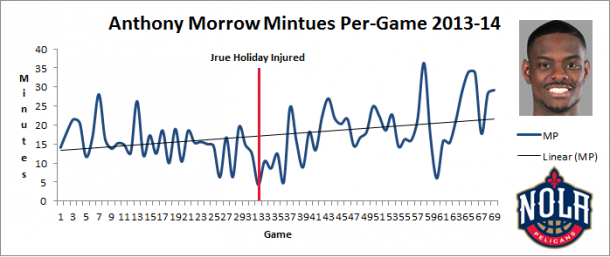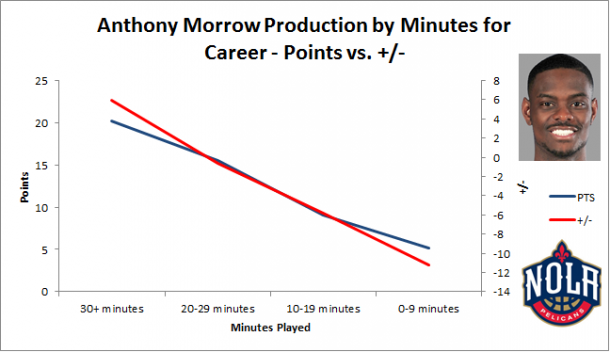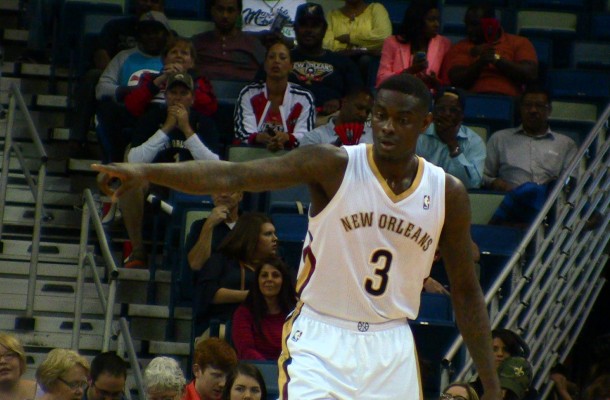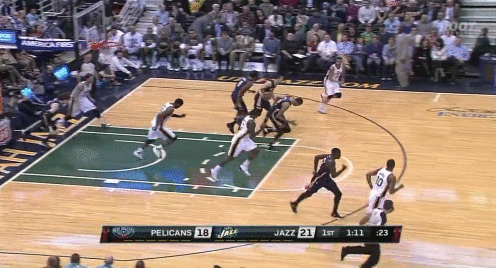I don’t even think about that [contract situation], I’m just trying to focus on winning these last few games. But I appreciate this opportunity because it’s been a blessing for me. — Anthony Morrow, April 6, 2014, The Advocate.
Anthony Morrow came into the NBA shooting 46 per cent from three in his rookie season. Since then he’s traveled around the league never finding a firm home. When traded from the Nets in 2012 Morrow has been pushed back on team’s depth charts.
Now, with injuries to the New Orleans Pelicans Anthony has received more playing time and flourished being the only consistent shooter on the team.
What’s amazing to see is his synergy with core Pelican players. Tyreke Evans and Anthony Davis seem to work well with Morrow and their games complement each other. As Evans drives on fast breaks he can find the sharp-shooter flanking down the perimeter. As for Davis, it seems that in isolations that having Morrow on the court can increase efficiencies in the half-court sets.
In a season of severe turbulence it is encouraging to watch certain players emerge.
Since the Jrue Holiday injury
Sports are as much about opportunity as they are about talent. Sometimes you have to be in the right place at the right time. For Morrow, prior to Jrue Holiday being injured, was receiving an average of 15 minutes a night. Since then it has increased to nearly 20 minutes a night.
Analysing how effective Morrow has been since Holiday’s injury produces both pleasing and sombre thoughts. On one hand Anthony has played well as we will highlight shortly. On the other we must remember that if not for an injury to Holiday would head-coach Monty Williams have thrown him into the lineup as frequently?


There is an indication that since Jrue Holiday’s injury that Morrow’s role has increased. As well there appears to be a correlation between this increase in playing time and his scoring numbers. Of any statistical category his scoring has increased the most.
Additionally his three-point shooting has improved significantly by over four and half per cent.
Adding a layer to this information, over his last seven games Morrow has averaged 18 points on nearly 52% shooting from 3 point-range. Facilitating these recent numbers are the increase in minutes per game, which rose equivalently to an average of 29 minutes a night.
All of these numbers are great. Morrow has seized an opportunity and has thrived to showcase his shooting and scoring ability with increased minutes.
But this begs the question, in a decreased bench role, will Morrow struggle to produce as well as he has?

As the graph above shows it appears that Morrow’s production does indeed decline as he sees a reduction in minutes. Points are skewed because the more minutes you get the more opportunities to score. But, by comparing with +/- we can see that the team’s Morrow has played on have performed better when he’s received more minutes and worse when he’s seen less.
We see this in almost every other category with Morrow. Offensive Rating, 3PT% and FG% also see similar trends.
Investigating other players we can see that this is a trend most players go through, but not as linearly as Morrow.
Who does he work well with?
By far the most interesting part of this season is looking into who Anthony Morrow plays best with. During most games this season the presumption is that he’s most effective paired with Anthony Davis and Tyreke Evans.

Well, there’s a surprise actually. Anthony Morrow and Austin Rivers are by far and away the most effective two-man combo overall. When on the floor they score more points than their opponent (4.6), shoot a better 3 point-percentage and have a better effective field goal percentage (1.6%).
One quick example of the two working well together is in the example above. Here we see Babbitt getting a block with Austin Rivers pushing the ball up the court and finding Morrow for a three. Notice how Ajinca runs down the middle drawing away Burks. Morrow continues to streak to the corner and Rivers is able to find him.
The other two man combinations worked well in different ways, but it’s very encouraging to see that when these two are on the floor that they produce very good results. The reason this is so exciting is that the way the team is constructed having Rivers and Morrow come off the bench will give Monty Williams reliability to hold serve.
However this is just the surface, what about 5-man units?

Monty Williams plays the Davis-Evans-Morrow-Roberts-Stiemsma lineup more than any other. This is because over the past 10-15 games Morrow has received more starts based from this lineup. It’s not completely ineffective, outperforming opponents in key statistical categories.
The most productive lineup is Ajinca-Babbitt-Evans-Morrow-Rivers. However, this has only played 24 minutes this season which is rather disappointing. In these limited minutes the lineup has outscored their opponents by a staggering 15 points. They shoot the ball more effectively both from three and from an efficiency standpoint.
This lineup also marries up with the two-man combo that alluded to Rivers and Morrow playing well together. Having Evans as the bulldog running the point with good spot up shooters seems to work well.
Areas you might not expect production
Anthony Morrow plays with terrific energy and passion. Whenever he plays he tries to assert himself into the game by displaying little fear when taking a shot.
We’ve talked plenty about his scoring impact; however does Morrow affect other areas of the game for the Pelicans?

The table above illustrates the difference in net rating when Anthony Morrow is either on or off the court. Their offense functions better than their opponents, they grab more rebounds and surprisingly they block more shots.
However digging deeper we discover that it’s not the offense driving these numbers. When Morrow steps on the floor Pelican opponents offensive rating declines by 4.1 points. The Pelicans offense itself does not change.
This is very intriguing because Morrow is not known for his defense, yet the team improves. The reason for this is the lineups he’s playing in. Tyreke Evans and Austin Rivers are consistently playing alongside Morrow. As such, Anthony is able to track the opponent’s shooter.
Using Synergy data we’re able to see that in spot-up and off-screen defensive plays that Morrow is directly responsible he holds the opponent to 33 per cent shooting. These make up 54 per cent of the types of defensive plays that Morrow faces.
Outside of the data I believe that Morrow brings something intrinsic to the Pelicans when he’s on the floor that helps explain this defensive improvement; communication.
Anthony Morrow yells and does a good job of pumping energy into the team when he’s on the court. He’ll ask for help when he needs it and on fast breaks will try to alert his team-mates when he’s open.
Take the Jazz game from a few nights ago. Is it any surprise that when the Pelicans were trying to make their run that Morrow was in the game? Utah got off to a quick start but when Morrow was inserted the bench held their own and increased the lead.
Moving into the future
If Anthony Morrow left the Pelicans it would be a shame. He’s developing on the court with team-mates, plays his heart out and represents what you want in a role player.
His relationship with Anthony Davis and Tyreke Evans appears to be a very good one. He works very hard and is oddly enough one of the senior members of the Pelicans.
Dell Demps does a terrific job of finding role players and this is another example of that. If Morrow opts out of his contract the Pelicans will have to do all they can to resign him.
Scoring is a highly valued trait in the NBA, so it’s likely that he’ll receive more money than the Pelicans could offer. Moving into the future Demps must look at the values Morrow brings outside of his scoring and evaluate whether he can be effective in other areas.
He can flat-out shoot. He loves the gym, which is something we value. He’s got some toughness about him, and will knock down big shots. — Head Coach Monty Williams, August 12, 2013, Pelicans.com


11 responses to “Anthony Morrow emerges for the New Orleans Pelicans”
Good column; enjoyed reading! A couple thoughts:
1) Instead of using +/- vs. minutes played per game, what about points per 36 minutes? That standardizes playing time. Not sure if the data is out there, but it probably wouldn’t be too hard to do in excel.
2) In terms of the top 2-man combos w/ Morrow, I worry about the impact of opponent quality on those rankings. For example, Rivers/Morrow may be better than Morrow/Evans statistically, but I’d imagine that Rivers/Morrow played most of their minutes against second units, whereas Morrow/Evans played more against starters.
Hopefully, we can bring Morrow back next year. He’s a great locker room guy and is truly an excellent shooter.
James,
My big deal when looking at two man line-ups isn’t a small (2-3point) increase in points, but the big change in offensive efficiency (especially 3pt efficiency where the Pelicans are so weak). So what jumped out at me was what the huge increase in net 3 pt efficiency (and lesser increase in 2 pt efficiency) with a two guard line-up of Morrow and Roberts. If they play with a driver/distributer like Evans, that looks like a deadly combination. What am I missing? [Why didn’t you discuss that?]
I always look at offensive efficiency before any other stat. When the most Pelican players have an offensive efficiency above (1.0) we usually win. To me, it is the advance stat that determines wins.
To any one, what do you think it will take for any team to sign Morrow? $4M/yr for 3 years?
Locking up A-Mo and finding a dance partner for Gordon this offseason. Kind of a big deal.
I enjoyed this.
504ever I wouldn’t be surprised to see a little more than that, (maybe $5ish) but I don’t think he’ll get over $2M per year.
Even if we assume Ryno comes back shooting 3s effectively, we still need 3 more guys who can shoot the 3 and are willing to do it often. I’m not counting Holliday, even though he shoots the 3 effectively. Babbit and Morrow are both worth keeping to fill 2 of those spots. Gordon could be the 4th one, but I’d rather it be someone who works harder to get open for 3. If we can move Gordon for someone who is taller than Morrow and quicker on D than Ryno, but shoots 3s like him, then we will have that covered.
I can’t see them spending no more than 2.5mil on Morrow. ..assuming they can’t move Gordon, they’ll have to find another big and a SF with about 8 to 10 mil in cap space. …
MasonGinsberg Thanks Mason! To address your concerns here is my response:
1) So I’ve standardised the increments in playing time by dividing the points by 9, 19, 29 and 39 the multiplying each result by 36 to get a rough estimate of per-36 by playing time. The results are as follows: 0-9 minutes: 20.51 points, 10-19 minutes: 17.18 points, 20-29 minutes: 19.2 points and 30-39 minutes: 18.7 points. So I guess this would standardise it and show no real relationship between scoring and playing time overall. However I would venture to say that it is pleasing to see that his per-36 numbers do not decline as he receives more playing time which leads to a sufficient volume overall.
2) I agree and did not analyse this in the piece. I wish there was data to show this, but the efficiencies are staggering to say the least. It wouldn’t be outlandish to think they could maybe hold their own against tougher opponents, though that is purely speculation.
504ever You are not missing anything I was looking at things from an overall stand point. This is also a capable combination. My only concern with Roberts and Morrow is the long term defensive implications. For instance, they have played significantly less than Rivers/Morrow. This is likely because there’s very few instances where Monty feels comfortable matching up Roberts and Morrow defensively.
As for the offensive efficiency statistics determining wins, I find it tough to discover any single statistical measure that has a causation effect on wins. Though I do agree that offensive efficiency statistics are the most important I think we also have to investigate things in their totality. Efficiencies don’t always remain consistent with playing time and you have to equate environments in which lineups exist.
Unfortunately I’m unable to give you answers on these because I just don’t have the resources at my disposal to give a definitive answer.
I hope you understand where I’m coming from. Thank you very much for your comment it highlights something I never really touched on in the article!
jsgrayson 504ever
James,
I wasn’t saying offensive efficiency was the most tell statistic for the NBA, but for the Pelicans this year. Maybe it’s because we shoot 3 so infrequently (and sometimes poorly) that we need a good level of offensive efficiency from many players to win. Maybe it’s because our defense is more consistent than our offense.
I do know that total points scored is much more related to the 5 players on the floor. 3pt shooting is much more related to the guards on the floor (especially with Anderson out) and improved 3pt shooting opens the floor for the 2pt shooters. So, when I look at the the three 2 man guard combinations shown above, Morrow-Roberts really stands out to me because of their offensive efficiency, especially 3 pt efficiency.
jsgrayson MasonGinsberg Morrow seems to be a bigtime mentor for Rivers. Something will have to give next year between the Rivers/Roberts/Morrow situation and thank you Monty for playing Roberts so much his QO jump to 3.2mil. It certainly makes it more enticing to go into FA with Brob as a FA than wondering if some team will match his $1mil QO thinking he’s value at $1mil, which he prob is. The problem is playing time and now that Monty has convinced himself Evans can’t play the 3, it only makes the situation worse.
Mason, on eye test alone, you can tell that level of competition doesn’t make much of a difference. For one, with Rivers playing 24ish or more minutes each evening, it stands to reason that he is going up again the other team’s starter for at least 12 minutes or more. Ditto with Morrow and playing 30 a night. Not to mention that it seems since Monty has gone to this atrocity of a starting lineup, the bench has pushed back or held serve in every game but one.
The biggest asset with the Rivers/Morrow tandem is their communication with each other. They’re always talking. Morrow always has Rivers back. And with Morrow blossoming, Rivers knows damn well the smartest thing to do is get Morrow the ball. Rivers tried to set a back pick to free up Morrow last night but PHX played it well. Rivers ran out to get the ball back. Morrow ran a curl to about 18-20 foot and Rivers gave it to him anyways and watched him drain a contested long 2. Each has an investment in watching each other succeed. Everytime Rivers gets down on himself or pulled by Monty, Morrow is always there to tell him to pick his ass up and let it go.